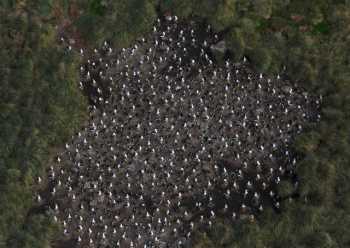A recent issue of the weekly newspaper Penguin News, which is produced in the Falkland Islands (Islas Malvinas)*, carried a report of a fire that threatened an important albatross colony
Grand Jason Island hosts a colony of c. 89 500 pairs of Endangered Black-browed Albatrosses Thalassarche melanophris. The uninhabited island is owned by the Wildlife Conservation Society (WCS), and is the largest of the Jason Islands Group Important Bird Area situated to the west of West Falkland. The island has not been grazed by domestic stock since 1968 and has no introduced rodents. Grand Jason also supports a large colony of ACAP-listed Southern Giant Petrels Macronectes giganteus – reported as numbering more than 800 pairs in the Visitor’s Guide (see below).
The fire was spotted from a yacht travelling to another island, Steeple Jason, in the group. Because nobody was ashore at the time it was deduced that the fire had been started by a lightning strike. Following a landing the fire was extinguished by cutting away the smouldering vegetation before it had spread to a nearby colony and caused any real damage “with only a few albatross nests affected”.
In 2002 a lightning strike coupled with dry weather caused a fire on Steeple Jason that was not fully extinguished until the next year. Steeple Jason, also owned by the WCS, supports large colonies of Black-browed Albatrosses and Southern Giant Petrels (over 1400 pairs). Again, fortunately, this fire did not reach the island’s albatross colonies.
It is clear that extreme caution has to be taken to avoid fires in the Jason Islands. Although tourist landings take place on Grand and Steeple Jason, no smoking ashore is allowed for this reason.

A Black-browed Albatross colony in the Jason Islands. Photograph by Ian Strange
Click here for a report on trends in the Black-browed Albatrosses of the Falkland Islands (Islas Malvinas)*.
Selected References:
Anon. 2013. Quick thinking farmers may have saved albatross colony. Penguin News 24(34): 13.
Strange, I. & Strange, G. 2011. Black-browed Albatross Thalassarche melanophris. Aerial Photographic Survey Methodology: Advantages over Ground Surveying in the Falkland Islands. Results and Comparisons with Surveys in 2005 and 2010. Stanley: New Island Conservation Trust. 30 pp.
Summers, D. 2005. A Visitor’s Guide to the Falkland Islands. Second Edition. Falklands Conservation: London. 132 pp.
Wolfaardt, A.[C.] 2012. An Assessment of the Population Trends and Conservation Status of Black-browed Albatrosses in the Falkland Islands. 23 pp.
Wolfaardt, A.C., Rendell, N. & Brickle, P. 2010. Falkland Islands Implementation Plan for the Agreement on the Conservation of Albatrosses and Petrels (ACAP): Review of Current Work and a Prioritised Work Programme for the future. Stanley: Falkland Islands Government. 57 pp.
With thanks to Anton Wolfaardt, Joint Nature Conservation Committee, UK for information.
John Cooper, ACAP Information Officer, 13 February 2013
*A dispute exists between the Governments of Argentina and the United Kingdom of Great Britain and Northern Ireland concerning sovereignty over the Falkland Islands (Islas Malvinas), South Georgia and the South Sandwich Islands (Islas Georgias del Sur y Islas Sandwich del Sur) and the surrounding maritime areas.

 English
English  Français
Français  Español
Español